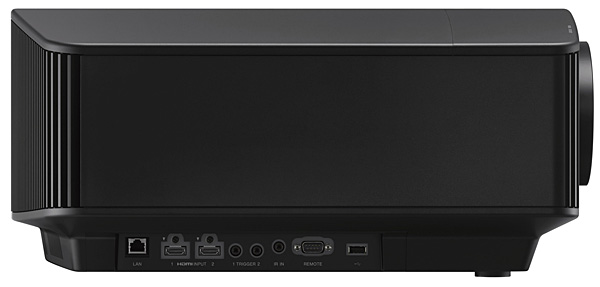Sony VPL-VW995ES LCOS Projector Review

AT A GLANCE
Plus
Breathtaking image quality
Reference-level optics
Laser light source
Minus
Low light output for price point
Lacks dedicated picture mode for HDR
THE VERDICT
The Sony VPL-VW995ES delivers reference-level images with all video formats and benefits from a high-end lens that's optimized for 4K playback.
In 2018, I reviewed Sony's VPL-VW885ES 4K laser projector, a $25,000 model that I hoped would be the successor to previous Sound & Vision Top Pick winners from Sony, the VPL-VW1000 and VPL-VW1100ES, but it fell slightly short of expectations. At CEDIA 2018, Sony unveiled its VPL-VW995ES, a next-gen step-up model in the ES projector line that sported the high-end optics missing from the VW885ES plus a few new tricks. The VPL-VW995ES appears to be a true successor to the earlier designs, but at a steep $35,000, does it have the chops to command such a lofty price? Let's find out.
 Fresh Features
Fresh Features
From a design and hardware perspective, the new VW995ES is nearly identical to the VW885ES that I reviewed last year. It features the same native 4K (4,096 x 2,160) SXRD panels, blue laser phosphor light engine (with a rated light output bumped up from 2,000 to 2,200 lumens), and signature Sony chassis. Connections are also identical: two full bandwidth HDMI 2.0b inputs, along with a pair of trigger outputs, a LAN connection, and a USB port for updates. One notable exception is the significantly larger lens that protrudes from the front of the VW995ES.
While the VW885ES used the same lens found throughout the bulk of Sony's projector lineup—a fact I wasn't thrilled with given its $25,000 price—the VW995ES features Sony's ARC-F (All Range Crisp Focus) lens, the same one provided on its flagship VW5000ES projector. This is a much larger, all-glass version that delivers the performance I would expect from any projector sitting at a price point north of 15 grand.
I was expecting the ARC-F lens to deliver an image quality improvement but ended up surprised at just how much of a difference it made. Focus was excellent across all areas of the screen—a performance parameter the VW885ES fell short on. Chromatic aberration was also significantly reduced, with convergence patterns showing almost no color fringing. The only artifact that presented some concern was the slight blue streaking that showed up with white text on a black background, or from bright white objects against a black background. This was easy to spot with my nose up to the screen but became completely invisible once I stepped more than a few feet back. Image quality from my normal viewing position was breathtaking.
The new lens also features a dynamic aperture that works with the projector's laser dimming system to increase contrast. I had a few nitpicks with the VW885ES's dynamic laser dimming, which I found to be too subtle with any content other than a full fade to black. The new iris on the VW995ES doesn't really add to measured contrast performance—black levels are slightly lower but contrast overall remains largely the same. I'll discuss that in more detail a bit later on.

A few new display enhancements can be found in the VW995ES's feature mix. The standout is Digital Focus Optimizer, a setting Sony touts as a digital sharpening tool that works with the projector's high-end lens to achieve better image quality. While I was surprised to see this on the VW995ES (high-end optics typically don't require enhancement), I found its effect during my testing to be similar to Darbee image processing in that it created a subjective increase in contrast in areas of small detail. The difference was subtle, but I could see many users appreciating the effect.
I rarely saw any issues with Digital Focus Optimizer enabled other than an obvious grid pattern when a bright object appeared onscreen when viewing the Ultra HD Blu-ray reissue of The Matrix Reloaded. I thought this might be an artifact related to the fine film grain present in the transfer, but I then viewed a number of significantly grainy films on Ultra HD Blu-ray that showed no artifacts at all. Based on my time with the projector, I doubt this will be an issue on most discs.
For the VW995ES, Sony has fine-tuned both its HDR tone mapping to deliver better shadow detail, and its HDR Reference picture mode to maximize performance with the more common 1,000 nit-based Ultra HD Blu-ray titles on the market. But I was disappointed to see that a dedicated picture mode for HDR hasn't been added. Instead, the projector simply uses the active picture mode and changes the Contrast adjustment and gamma. Since there are a number of settings that require adjustment for best HDR viewing (most notably the projector's laser light output), it would be far more convenient if the projector automatically switched to a preset that's optimized for HDR so you don't have to tweak settings every time you jump between formats. However, you can save your preferred settings for HDR content in one of Sony's nine Picture Preset registers and manually call up that preset for watching HDR content, which is what I did during my time with the VW995ES.
Setup
For this review, the VW995ES was paired with my reference 11-foot-wide Stewart Filmscreen Studiotek 100 (unity gain) 2.35:1 “scope” screen. The projector was mounted to the ceiling using the same Chief mounting system that I used for my VW885ES review, and at the exact same throw distance for direct comparisons of measurements and light output levels. Since I use a 2.35:1 aspect ratio screen, I set two lens memories. Sony already has the first two memories named for precisely this type of setup—easily accessible from a button on the remote—and the adjustment only took about 15-20 seconds to complete. Settings for focus, zoom and lens shift are all saved. There are also adjustments for blanking, to eliminate objects that may fall outside the screen surface when zoomed out, and for aspect ratio control, which are also saved.





























































